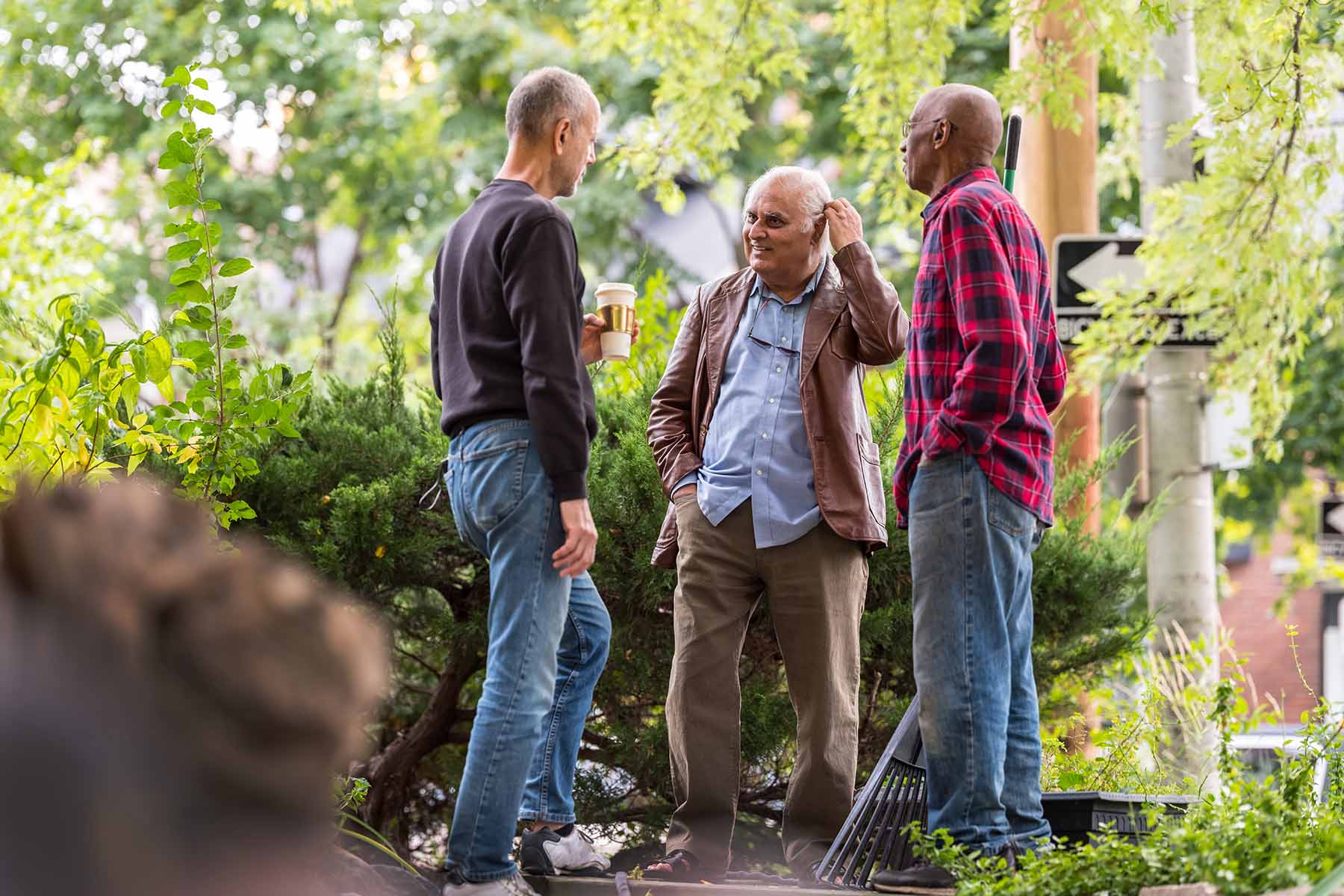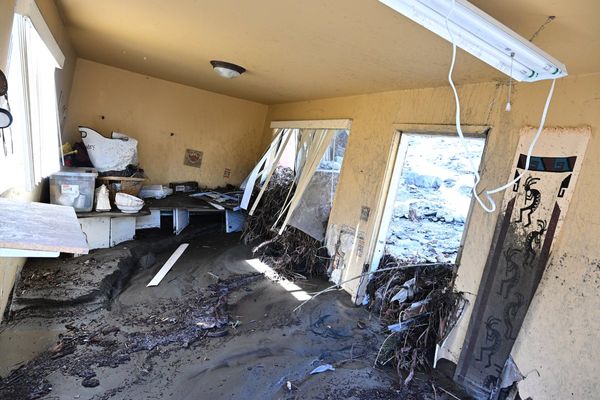
Like many Canadians who watched news footage of nursing homes during the COVID-19 lockdown—the blurred faces looking out at families on the other side of the window; the masked and exhausted staff; the terrifying ongoing tally of the infected and dying—I made a pact with myself that there would be no old-age home in my future. How I’d make that so, however, was as blank as a sheet of paper. Or it was until the cold Tuesday afternoon I joined the raucous soup social at the Stanley Knowles co-op in midtown Toronto.
On the outside, the co-op is a nondescript brown-brick low-rise. But inside is a social movement that could change the future for the 2.5 million Canadians moving into their peak care years like a thundering avalanche (the silent generation we are not). Many of those older Canadians are moving out of their single-family homes and into multi-residential buildings, looking for the same kinds of things: a turnkey operation, so they can spend less time on maintenance; no stairs; less economic pressure; easy access to amenities; and, especially, a built-in community of people who value their autonomy and independence. People who are prepared to “do everything they can” to avoid being housed in an institutional setting, according to a National Institute on Aging and Canadian Medical Association survey of Canadians sixty-five and over.
“All of us here have many people who died in nursing homes during COVID.” Christina Doyle, my tablemate at the Tuesday soup social and a resident of Stanley Knowles for thirty-nine years, waves her hand around the packed room. There’s a lot of joyous and possibly competitive picture sharing on iPhones, along with shouts of “Who needs a ride tomorrow?”, plus I can’t stop watching two guys poking around at the ceiling panels over by a large flat screen TV. “The government’s big idea is to take us out of our environments instead of keeping us in our homes,” says Doyle, eighty-three. Ontario premier Doug Ford’s controversial More Beds, Better Care Act of 2022 can move aged, extended-stay hospital patients to nursing homes as far as 150 kilometres away. “It isn’t the way any of us want to go.”
And now it doesn’t have to be, thanks to something called NORC, which stands for naturally occurring retirement communities. Toronto’s University Health Network (UHN) runs a NORC program designed to help people age in the place of their choosing by bringing services to where older Canadians have already congregated in large numbers. In Toronto, that mostly means the boom in high-rises that is quickly changing the skyscape of the city. Stanley Knowles is one of the first of Toronto’s now twenty-three operational NORCs.
“The question was: How do you make a model of an aging community?” I’m talking on the phone with Jen Recknagel, the director of innovation and design at UHN’s NORC Innovation Centre. “And the answer was: Start with where they are.”
That NORC is not trying to create something new is the most radical thing about it. Instead, it’s energizing or “catalyzing”—a popular NORC word—an existing movement of a whole bunch of people with similar needs living under the same roof. People who value being “members of a community where their voices and opinions matter,” says Recknagel.
To qualify for UHN’s NORC program, those pre-existing communities need to have 30 percent or more adults aged sixty-five and over; 76 percent of Stanley Knowles residents, for example, are sixty-five and older. Once NORC is established in a building or community, UHN delivers a variety of health and social supports, coordinating a network of care partners to bring in things like talks from paramedic teams, vaccine clinics, exercise programs, and social events—whatever the community itself decides it wants most.
NORCs have been successfully operating in New York City since the mid ’80s and are even publicly funded there. But in Canada, they’re little known outside of Toronto—and hardly known there either. Rental apartment buildings, condos, and co-ops like Stanley Knowles are what are known as vertical NORCs, while a horizontal NORC might be any congregation of single-family homes within a specific geographical area. (UHN does not currently have any horizontal NORCs in its program.) So far, there’s no open application process to join UHN’s NORC program, but there is a do-it-yourself (DIY) guide for people interested in starting up an aging-in-place network in their own community.
“What used to happen when we needed help was we’d call around to our local MPPs and social service groups, trying to figure out what was available in our catchment,” Doyle says. “They were all so busy and overworked.” Having helped navigate my parents through the gauntlet of assisted home care, I’m familiar with the acres of time it can take. Doyle heard about NORC in 2020, during lockdown, and immediately investigated how her co-op could join. Today, nurse practitioners, monthly check-ins with paramedics, equipment sharing, foot doctors, and social events like the one I’ve joined today are all supported and sometimes funded by NORC. And, vitally, after Doyle fractured her pelvis last summer, the NORC nurse practitioner quickly arranged for her to go to the hospital for X-rays and then to to rehab after surgery. When Doyle came home, the NORC occupational therapist came to see how she was doing, checked her apartment for tripping hazards, and helped Doyle choose a walker. Without any these supports, Doyle might have easily been moved to a long-term care facility, the place she dreaded most. In the future, Doyle would love to see one or two personal support workers working full time in the building, but for now, “NORC is here for what we decide we want and need.”
“More bike racks out front, add that to the list,” says a fit man carrying a helmet as he joins our lunch. Howie Abrams turns out not to be a co-op resident but a general internist at Mount Sinai Hospital and UHN and one of the initial movers behind NORC in Toronto. “I saw too many seniors abandoned to understaffed hospitals, with nowhere else to go but government-run nursing homes, to believe that there couldn’t be a better way.”
Abrams says there’s a ton of great research going on but very little practical help for our aging population. He is the director of UHN’s think tank, Open Lab, of which NORC is an offshoot. “You need to approach a problem like this with humility, because you don’t know the answer; you often don’t even know the question,” he says. “Success is when a resident comes to me at an event like this with a new idea.”
I ask if all twenty-three active UHN NORCs are like this one, and Abrams gives me a quick tutorial: There’s no right model to “catalyze” a NORC. Some have full- or part-time NORC staff on site (Stanley Knowles has a staff member three days a week); others are run by the residents themselves, using NORC simply as a resource. The program is funded by a “very generous and anonymous private donor,” Abrams says. Abrams and Recknagel are ambitious for their model to be repeated across Canada, with NORCs integrated into and supported by Canadian health care systems. “It’s twenty-first-century integrated care using community-led solutions for aging in place with dignity and choice.” Abrams could be reading this from a brochure, but he isn’t. He’s just passionate about NORC. “Who can argue with that?” he says.
When I wonder aloud if there are any NORCs in my neighbourhood, Abrams shows me the data map of the nearly 500 potential NORCs in the city, and I’m surprised and pleased to see at least four of them are a few short blocks from where I live. I like the idea of staying close by if I move to a place that is less demanding than my house but is not the dreaded nursing home. I’m not sure I’m a community person, though. I like being on my own.
“True, some people just aren’t community oriented,” Abrams says. But he also points out that social isolation is a huge risk factor for health issues. And “even bacteria form communities.” Abrams looks at me. “You are a community of bugs. There are more bugs in you than you.”
Plus, there’s the neighbour capital: retired CEOs, lawyers, plumbers, electricians, doctors, and engineers could be living right next door. “Can’t open a can? Can’t change a light bulb?” (My regular bottle of cranberry juice requires my son to come by and open it, and I haven’t been able to change a pot light since 2008.) “There’s going to be someone nearby who can.”
By now, one of the two guys over at the TV has brought out a ladder and is climbing up to look behind a ceiling panel while the other uses a flashlight built into the end of his cane to light the way.
“What are you guys up to?” I love a man with a tool kit.
“We want to mount this TV on the wall,” says Bryan Day, the one with the flashlight. Please don’t ask me what ceiling panels have to do with wall-mounting a TV; it’s out of my ken. See above, re: pot lights.
I sit down with Bryan, who shows me the various attributes of his terrific cane, which also has a built-in alarm. “The problem with a lot of older people is they start to get frightened and isolated” instead of helping each other, Bryan says. “Things need to get done, and they don’t get done if you don’t go up the ladder.”







